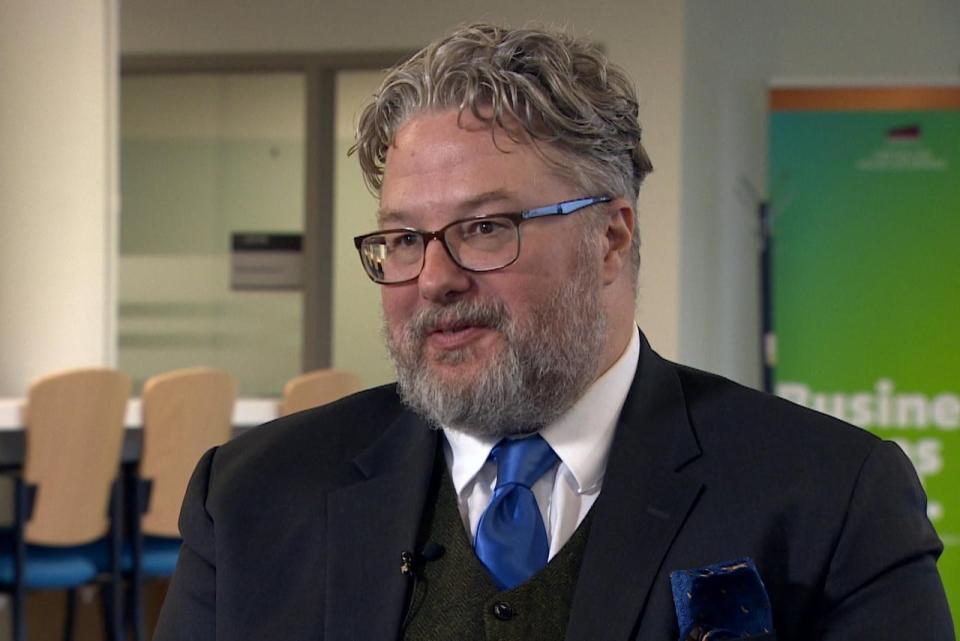31% of Newfoundlanders and Labradorians struggling to meet basic needs: Vital Signs report


Cathy Newhook is the manager of public policy and communications with the Harris Centre. (Mark Cumby/CBC)
Picture a room with 100 Newfoundlanders and Labradorians crammed inside.
Thirty-one of those people would be struggling to meet their basic needs like transportation, housing, food and clothing.
Twenty-six would be struggling to afford food.
Twenty of them would be experiencing housing insecurity.
These are the sobering numbers contained within the Harris Centre's annual Vital Signs report, released Thursday morning in St. John's.
Vital Signs aims to unearth the biggest issues in the province by taking a closer look at a wide range of statistics. This year's main topic — the cost of living crisis — was no surprise.
"If the key issue for all of these people boils down to cost of living, then that's where we should probably be focused," said Cathy Newhook, manager of public policy and communications with the Harris Centre.
The report digs into housing, food, child care, population change and more. It also gets regional, recognizing that the situation in St. John's looks different than the situation in rural or Indigenous communities.
On the whole, the consumer price index has seen a 22 per cent increase over the past five years. When you break it down into categories, transportation and shelter have gone up by 26 per cent while food has gone up by 15 per cent.
Food bank usage has been one of the most stark consequences of the rising cost of living, rising 44 per cent in the last four years as more than a quarter of homes report experiencing food insecurity.
Housing concerns top of mind
The report also painted a problematic picture of housing in the province, with varying issues from the four coasts of Newfoundland to the north coast of Labrador.
Housing prices have risen 29 per cent in the past five years, while vacancy rates have shrunk from 7.5 per cent in 2020 to 2.9 per cent as of the latest numbers in 2022. That's part of a myriad of circumstances that have resulted in a skyrocketing rate of homelessness in the province — a staggering 57 per cent increase from February 2023 to February 2024.

Tom Cooper, a business professor at Memorial University, wrote about the challenge of balancing housing as a human right and housing as an investment opportunity. (Mike Simms/CBC)
Business professor Tom Cooper contributed to the report, saying we need to rethink how we view houses — either as commodities or a basic human right.
"As homes become viewed primarily as investments, their prices are driven not just by the demand for shelter, but also by their potential to increase in value and generate rental income," Cooper wrote. "The current challenge for housing lies in finding a balance that allows us to satisfy our basic need for shelter and to pursue economic security through investment."
The report also looked at how housing concerns vary from place to place.

A 2018 housing needs assessment completed by the Nunatsiavut government found 41 per cent of households surveyed had mould. (Ariana Kelland/CBC)
In the St. John's metro region, for example, 19 per cent of people cite affordability as the largest factor in housing insecurity while four per cent cited the condition of their homes. In the Nunatsiavut region, however, 28 per cent of people cited the condition of their homes and four per cent cited affordability.
Immigration outweighs record high deaths and low births
Newfoundland and Labrador's population problems have long been a fascination for the Harris Centre. This report was no different.
Between July 2022 and July 2023, the province recorded a record high number of deaths, a record low number of births and a record high number of new immigrants.
The rate of natural change — births minus deaths — came out to a staggering -2,560 for that time frame. Despite that, the province's population was able to grow due to the arrival of 3,854 new non-permanent residents.
Just three per cent of the province's current population are immigrants, but the number is expected to double by 2041.
When immigration becomes emigration
However, the report also highlighted a hurdle for that prediction. Immigrants in Newfoundland and Labrador report feeling much higher rates of loneliness than the Canadian average, and far higher than non-immigrant residents of the province.
Laurabel Mba, an anti-racism consultant, said a big problem is connection to services when they arrive.
"What we're realizing, though, is as racialized immigrants show up or as immigrants as a whole show up ... there's a deep lack in the services, products and provisions necessary for them to find themselves at home," she said.

Laurabel Mba says making newcomers feel welcomed is a huge part of preventing them from leaving for new places. (Mark Cumby)
Further, Mba said many newcomers arrive in the province as part of a contract with an employer, and when that ends, they leave for bigger cities.
"We have this idea of Newfoundland and Labrador as the most welcoming, the most friendly. And we do a great job of that on a tourist aspect," she said. "But when it comes to people actually finding permanence within our province, it's hard to find if you can't access the things that make you feel at home."
Download our free CBC News app to sign up for push alerts for CBC Newfoundland and Labrador. Click here to visit our landing page.

